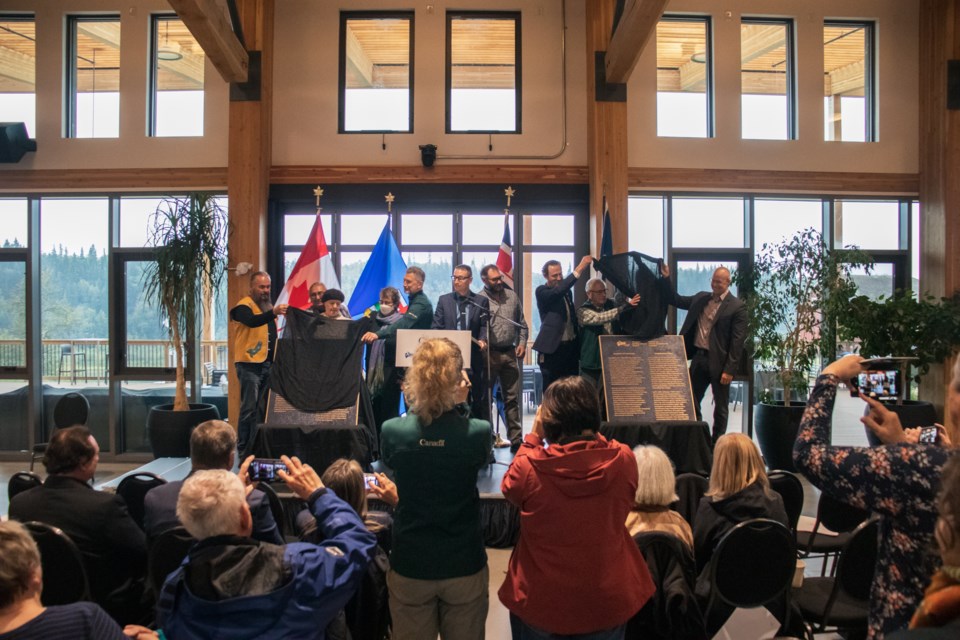In March 2024, the Alberta section of the North Saskatchewan River, spanning 718 kilometres, was officially designated as a Canadian Heritage River, following an initial nomination by the Smoky Lake County in 2019.
Previously, only a 49-kilometre section within Banff National Park held the designation.
Parks Canada held a ceremony at Métis Crossing near Smoky Lake on Sept. 14 to commemorate the occasion. New plaques will also be installed at the Victoria District National Historic site.
The North Saskatchewan River has long served as a vital cultural and trade route for Indigenous peoples and early settlers, as well as a gathering place for Indigenous nations such as the nêhiyawak (Cree), Métis, Nakota Sioux, and many others, providing a transportation route that was pivotal to the fur trade and early human settlement patterns.
Karin Smith, acting program advisor for the Canadian Heritage River System, the body that designates Canadian Heritage Rivers, also highlighted the economic and tourism opportunities that could arise from the designation, especially as the river already draws an influx of kayakers, canoers, and recreational tourists.
“Tourism is a growing sector, and recreation is one of the reasons that the North Saskatchewan was designated,” she said, explaining cultural heritage and recreation were the two values that were identified.
While recreation and tourism are important to the economic development in the region, local leaders also emphasize the need to balance development with the preservation of the river's unique values.
Scott Millar, executive director of the Northern Saskatchewan Watershed Alliance, noted the importance of protecting the river amid increasing development pressures.
“The other really interesting part of the designation is this doesn’t affect or impede development. It's just a recognition of the values that need to be recognized when you're doing those kinds of developments,” and it takes a group of people and communities to find the best path forward, he said.
Kyle Schole, vice chair of the North Saskatchewan Watershed Alliance’s board, agreed and expressed optimism for future collaboration between municipalities, regarding economic developments that might arise concerning the river.
“Previously, when I was with the Smoky Lake County . . . we were working on, and continue to be working, on an economic development strategy that's very much vested in heritage tourism and cultural exchange,” he explained.
This means looking at opportunities to encourage new tourism opportunities up and down the Victoria trail, which is one of the reasons why the County sought to have the river designated, he explained.
Over a dozen municipalities expressed their interest in developing economic opportunities, such as tourism, along the river. “I’m personally hoping for more collaboration,” said Schole.
“The river doesn't notice when it flows from Lamont County into Smoky Lake. . . These invisible lines that we humans draw on maps don't really exist out in the environment,” which is why collaboration is important between multiple jurisdictions, Schole explained.
Asked what type of partnerships those might be, Schole said specific examples could be municipalities pooling resources together to map out canoe routes, and creating smart signage that tells the stories of the river, or information that indicates risks and opportunities for passing visitors.
“The ground that we're standing on now is a short two-day canoe ride from the City of Edmonton, and I know that that’s an increasingly popular route,” he said.
More recreational activities means more traffic, which comes with more risks, Schole added. At some point, “We have to look at things like emergency services and ensuring we have the means to assist people.”
“This river is a powerful force to be reckoned with,” said Schole.
John Tschir, Director of Land Management Branch at Alberta Environment and Parks, said he agrees that the designation will welcome yet another level of collaboration between municipalities not previously seen in history.
“When you think about a river as a linear feature, it goes through many communities. And piecing those communities together in terms of having a shared vision for recreation on the river will be a huge part of the work that's been done and will continue to be done,” said Tschir.



